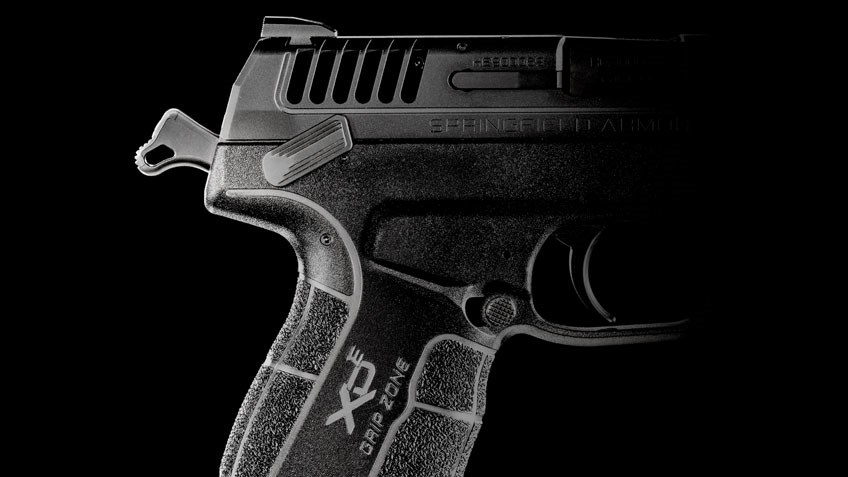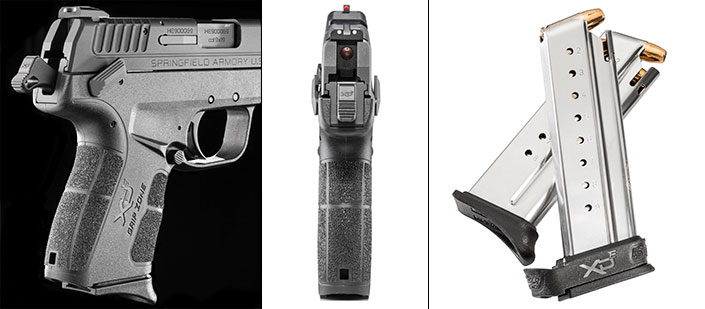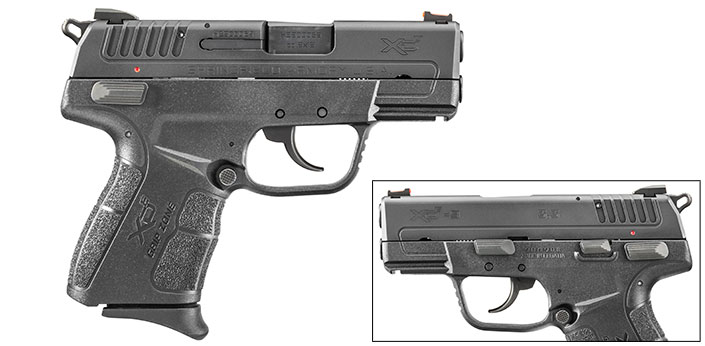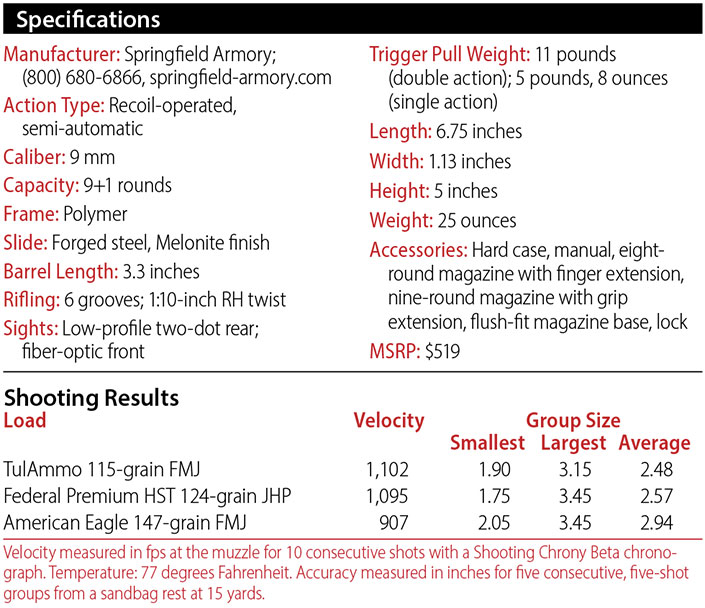This outstanding handgun flaunts a rebirth of a trigger mechanism, and design, that has been overshadowed in the vast array of common striker-fired pistols, but one that has strong merits. Read more…

SOURCE: Shooting Illustrated, by Tamara Keel
There was a time, back in the 1970s and ’80s, when giants strode the earth of the desert Southwest. At the time, semi-automatic handguns came mostly in two flavors: Single-action pistols — which were endorsed and carried by these giants –and pistols that were double-action on the first shot and single-action on subsequent shots, which were derided by the giants as “crunchentickers.”
The logic behind these sorts of pistols was that they could be carried safely decocked, yet be ready to fire with just a pull of the trigger. The downside was that the transition between the long, heavy initial trigger pull and the subsequent lighter, shorter pulls required more initial training and sustainment practice to maintain proficiency. So, the “crunchenticker” was seen as the lowest-common-denominator issue gun, while the real shooters used single-action pistols.
And, fast-forward to 1985, then came the striker-fired Glock and soon after all of its market competitors. Featuring only a single trigger pull to master, these pistols quickly became the singlemost-common variant in domestic law enforcement (and, anecdotally, coincided with a jump in qualification scores at police departments across America) and private-citizen use.
Fast forward to the present day, and in some sectors there’s a renewed interest in hammer-fired, traditional double-action (TDA, for short) pistols among a varied spectrum of serious shooters, and for a number of reasons.
In the competitive-shooting world, TDAs started owning Production Division in USPSA and IPSC. This was partially because so many current models were metal-framed and heavier than their striker-fired, polymer competitors. The TDA trigger itself was a big factor, too. As a friend explained to me, “You get one lousy trigger pull and 10 great ones, rather than 11 mediocre ones.”
On the tactical side of things, I know a few instructors who strongly favor the longer initial pull of the TDA in defensive guns for the reason that these pistols are threat-management tools. Guns get drawn — and even pointed — a lot more often than they get fired, they explained, and that longer trigger pull can be an added cushion against a nervous trigger finger getting into the wrong place.
One last reason for the renewed interest in hammer-fired TDA pistols is the increase in popularity of Appendix Inside-The-Waistband (AIWB) carry. When holstering in an AIWB holster, the user can control the hammer of a TDA pistol with the thumb of the firing hand. This serves the purpose of alerting the shooter to any unnoticed obstructions that may have gotten into the trigger guard and snagged the trigger by letting them feel the movement of the hammer.
Unfortunately for enthusiasts of the hammer-fired pistol, the selection on the market isn’t what it used to be, especially in the concealable, mid-priced variety. Furthermore, while Beretta, SIG Sauer, and Heckler & Koch all offer concealable TDA pistols, all but a couple up-market offerings from SIG are double-stack guns, and right now the market is madly in love with slim, single-stack concealment pistols for CCW.
The Springfield Armory XD-E, a single-stack, polymer-frame 9 mm, took the market by surprise early in 2017, representing a new addition to the company’s line of XD pistols.
While it uses the name and familiar styling elements of the XD series of guns, including the prominent “GRIP ZONE” markings on the grip, the Springfield Armory XD-E is pretty much an entirely different pistol. It shares almost nothing but the magazine and sights with Springfield’s existing single-stack line, the XD-S, and even there it only uses the XD-S extended magazines.

In size, heft and overall concept, the Springfield-Armory XD-E reminds one of the long-discontinued Smith & Wesson 3913. It’s just slightly larger than the Glock G43 or Smith & Wesson M&P Shield, since the standard magazine holds 8 rounds and the spare that ships with the gun is a 9-rounder with a grip-sleeve adapter. The magazines both come fitted with pinky rest extensions on their floorplates, but these can be switched with flat floorplates (included) for those who prefer a flush-fit contour for concealability.
The grip is as slender as you’d expect from a polymer-frame, single-stack gun. The widest point of the pistol, measured across the low-profile ambidextrous thumb safeties, is only 1.125 inches.

Those ambi thumb safeties function in the same fashion as the classic 1911 thumb safety: up for safe and down for fire. Pressing down further past the off-safe position safely de-cocks the hammer. The magazine release is also fully ambidextrous, but the slide release is single-sided. The slide stop was a little difficult to run when the gun was new, but became easily useable after a few boxes of ammo.
Atop the slide on the Springfield Armory XD-E are sights compatible with the current XD dovetail dimensions (which are, entirely uncoincidentally, the same as the classic SIG Sauer P-series.) There’s a Novak-esque no-snag rear sight with two white-painted dots, and the standard front sight on the gun is a fiber-optic unit with a very visible red light pipe. Between the front and rear sights is the familiar loaded-chamber indicator of the XD-series — a hinged tab that pops up when there’s a round in the chamber.

The slide has six broad, but shallow, grasping grooves on each side at the rear, and forgoes the current trend toward forward cocking serrations, which is probably a good idea on a pistol with a 3.3-inch barrel. All in all, the ergonomics on the Springfield Armory XD-E are solid. The textured areas are grippy without being too aggressive, and it’s not textured where it doesn’t need to be. The trigger guard could be a little larger, though. Folks with big fingers might have difficulty while wearing gloves when the trigger is in its fully forward, double-action position.
While it’s technically possible to carry the Springfield Armory XD-E cocked and locked in “Condition One,” the low-profile thumb safeties don’t exactly encourage it. Instead, the simplest thing is to load the pistol, chamber a round, use the safety/decocker to safely drop the hammer, and then holster up. Personally, I’d be interested in a decocker-only version to avoid the possibility of inadvertently actuating the safety when I didn’t mean to, but enough folks like the belt-and-suspenders approach of both a double-action pull and a manual safety that Springfield Armory chose to introduce this version.
At the range, the pistol shot well — frankly, better than I expected. I was anticipating an experience along the lines of what I’ve had with a G43 or a Shield, but the slightly larger size of the Springfield Armory XD-E pays dividends in shootability, thanks to a larger grip and enhanced recoil control. At the pistol’s launch event in Las Vegas, stages were set up with targets as far as 50 yards, and the better shooters among us were knocking those over with aplomb.

This was aided by a very usable trigger. My Springfield Armory XD-E test sample’s double-action trigger pull gauged at 11 pounds and, while it stacked noticeably prior to break, it was plenty smooth. Single-action measured 5.5 pounds, with a short take-up before hitting a fairly abrupt “wall,” and then finished in a rolling break. Most impressively, through all the demo guns I fired over the course of the launch event, plus 750 rounds of assorted ammunition through my T&E sample, I have yet to see any malfunctions.
The Springfield Armory XD-E has a niche to itself for now. The only hammer-fired TDA single-stack 9 mm in the same size class is SIG Sauer’s metal-frame P239, which is 5 ounces heavier and has an MSRP nearly double that of the XD-E. Sitting right at the confluence of two trends, AIWB carry and single-stack, subcompact 9 mm pistols, it will be interesting to see how well the XD-E does in the marketplace. If it sells, will other models be spun off the gun’s TDA lockwork? Maybe a full-size, single- or double-stack service pistol? Stay tuned…










